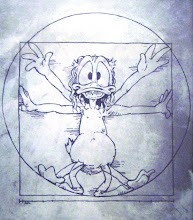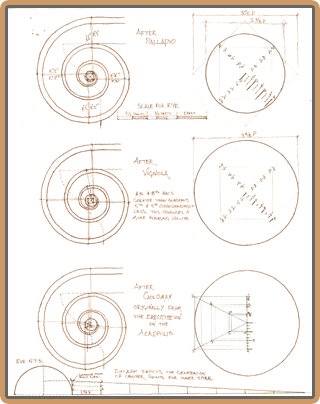I was thinking a bit about some of the comments I made in my previous post on the critique of the Getty Villa, and the tweaking of 'fiction' in architectural critique.
In order to flesh out the differences between a healthy and unhealthy application of fiction, I'm going to compare two iconic products of two diametrically opposed architectural, nay: philosophical, nay; theological, ideologies: the traditional versus the modernist represented by the Cathedra Petri in the Vatican by Gianlorenzo Bernini and The Federal Center in Chicago by Mies van der Rohe, respectively.


First, let's take a look at the Cathedra Petri. After some time, one's eyes adjust to the apparent over-articulation of forms. This is not, in fact, over-articulation, but just your American eyes not being used to seeing art. Here we have four doctors of the Church supporting a great bronze chair-the Chair of Peter-Ss. Ambrose, Athanasius, Augustine and John Chrysostom. Now, look closely.
 We see that the chair is being supported not by the shoulders of Atlantean Laborers, but by rather limply draped ropes suspended from the unstrained fingertips of the inattentive doctors. This is the fiction. There are twelve and a half tons of bronze suspended in the air, and we can clearly see that it's not falling. The structural reality of the chair's existence does not spring from the exact same reality that references the doctor's world. This is the tension of the Baroque. And the genius of Bernini comes through for us who care to resolve the tension. Bernini points us to the amorphous cloud, and the heavenly horde that is part of that cloud (notice also that the angels and putti are the same color as the cloud-no contrast is applied where you want the subject to disappear.) This amorphous cloud then winds its way down to underneath the chair, implying that the same force holding up the heavenly bodies is holding up the chair. While it may not be true to the natural world that such a weight can float, it is certainly within the purview of a God whose power is unbound. It is not merely natural, it is supernatural. It is not worldly, it is heavenly. This is fiction as it is meant to be. Sure, the characters don't exist, but they're believable and are interiorly consistent. They represent a reality that is normally beyond the grasp our senses. And the sensibilities of some like Mies van der Rohe.
We see that the chair is being supported not by the shoulders of Atlantean Laborers, but by rather limply draped ropes suspended from the unstrained fingertips of the inattentive doctors. This is the fiction. There are twelve and a half tons of bronze suspended in the air, and we can clearly see that it's not falling. The structural reality of the chair's existence does not spring from the exact same reality that references the doctor's world. This is the tension of the Baroque. And the genius of Bernini comes through for us who care to resolve the tension. Bernini points us to the amorphous cloud, and the heavenly horde that is part of that cloud (notice also that the angels and putti are the same color as the cloud-no contrast is applied where you want the subject to disappear.) This amorphous cloud then winds its way down to underneath the chair, implying that the same force holding up the heavenly bodies is holding up the chair. While it may not be true to the natural world that such a weight can float, it is certainly within the purview of a God whose power is unbound. It is not merely natural, it is supernatural. It is not worldly, it is heavenly. This is fiction as it is meant to be. Sure, the characters don't exist, but they're believable and are interiorly consistent. They represent a reality that is normally beyond the grasp our senses. And the sensibilities of some like Mies van der Rohe.Dignum et iustum est that our starting point be with the words of Mies himself: "Less is more." IF this is true, or at least if Mies believed it, then what is there must be exceedingly important.
 Clearly, the unarticulated quasi-platonic form of the Federal Center Buildings are, from a distance, meant to convey that the form is the surface of a hollow parallelepiped (how I love that word). And what is that surface? Glass. (and steel ribs, but those ribs, however structural in reality, only give the impression that they're there for holding the sheets of glass skin on the building). And if one takes the literal meaning of glass as a structural material at face value, does it convey the idea of structural stability or fractural farcicality? Ok, so the glass isn't structural.
Clearly, the unarticulated quasi-platonic form of the Federal Center Buildings are, from a distance, meant to convey that the form is the surface of a hollow parallelepiped (how I love that word). And what is that surface? Glass. (and steel ribs, but those ribs, however structural in reality, only give the impression that they're there for holding the sheets of glass skin on the building). And if one takes the literal meaning of glass as a structural material at face value, does it convey the idea of structural stability or fractural farcicality? Ok, so the glass isn't structural.  Then what is? Take a closer look at the ground level- the entire building is resting upon stilts of steel at the perimeter, and a clear glass 'foundation', which in no way instills the notion of safety upon those who are underneath it. So, it's obviously the steel stilts that are holding everything up, right? BUT, they are punching right through the parallelepiped: leaving the impression that the whole ensemble should, without intervention from outside its own closed system, puncture right through the bottom of the superstructure, crushing all hapless ground floor visitors. So what keeps such calamaties from happening? Nobody knows. There is nothing there to tell us other than an assumption that human reasoning can overpower gravity. And it's made to feel like the superstructure is defying the same gravity that Bernini's doctors are, but this time without a hint of what superhuman beings are acting in the natural world. Less is more. What is not there must not be important. Moreover, it must be important that it's not there. The fiction of Mies and the modernists is profoundly indeterminate. It is a true fiction, because it doesn't exist. Not that it doesn't exist in reality and yet somehow lives in the imaginative intellect, but that it purposefully projects the non-being of order. The non-being of being. Modernist architecture, in fictionalizing possible artificial structures, is fictionalizing the natural structure in the cosmos. It is not supernatural, it is other-natural. And the 'other' is purposefully undefined-there is no reference to the existence of an intervening principle outside the closed system of our physical world. Modernism in architecture, as in philosophy, is the anti-god.
Then what is? Take a closer look at the ground level- the entire building is resting upon stilts of steel at the perimeter, and a clear glass 'foundation', which in no way instills the notion of safety upon those who are underneath it. So, it's obviously the steel stilts that are holding everything up, right? BUT, they are punching right through the parallelepiped: leaving the impression that the whole ensemble should, without intervention from outside its own closed system, puncture right through the bottom of the superstructure, crushing all hapless ground floor visitors. So what keeps such calamaties from happening? Nobody knows. There is nothing there to tell us other than an assumption that human reasoning can overpower gravity. And it's made to feel like the superstructure is defying the same gravity that Bernini's doctors are, but this time without a hint of what superhuman beings are acting in the natural world. Less is more. What is not there must not be important. Moreover, it must be important that it's not there. The fiction of Mies and the modernists is profoundly indeterminate. It is a true fiction, because it doesn't exist. Not that it doesn't exist in reality and yet somehow lives in the imaginative intellect, but that it purposefully projects the non-being of order. The non-being of being. Modernist architecture, in fictionalizing possible artificial structures, is fictionalizing the natural structure in the cosmos. It is not supernatural, it is other-natural. And the 'other' is purposefully undefined-there is no reference to the existence of an intervening principle outside the closed system of our physical world. Modernism in architecture, as in philosophy, is the anti-god.What's most disconcerting is that Mies knew what he was doing. He kept a copy of the Summa Theologica at his bedstand, from which he read in 'order to better know what it was he was refuting'. Today's theorists, practitioners, and critics just don't have that ideological fervor, however wrong. Most of the time they don't even know that they are even complaining about fiction whilst taking it to the bank. If the unexamined life is not worth living, then by extension their professional lives are not worth professing.
God willing, someday society will view their thoughts not worth thinking and their buildings not worth building.



No comments:
Post a Comment